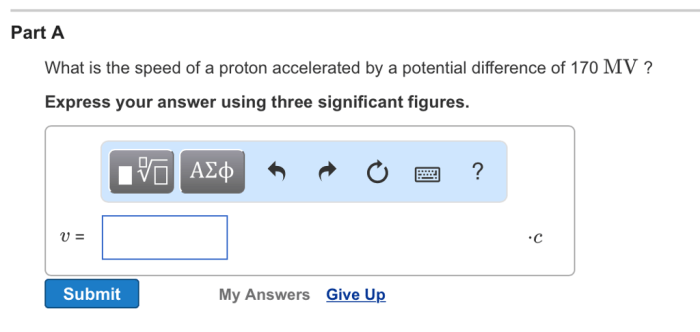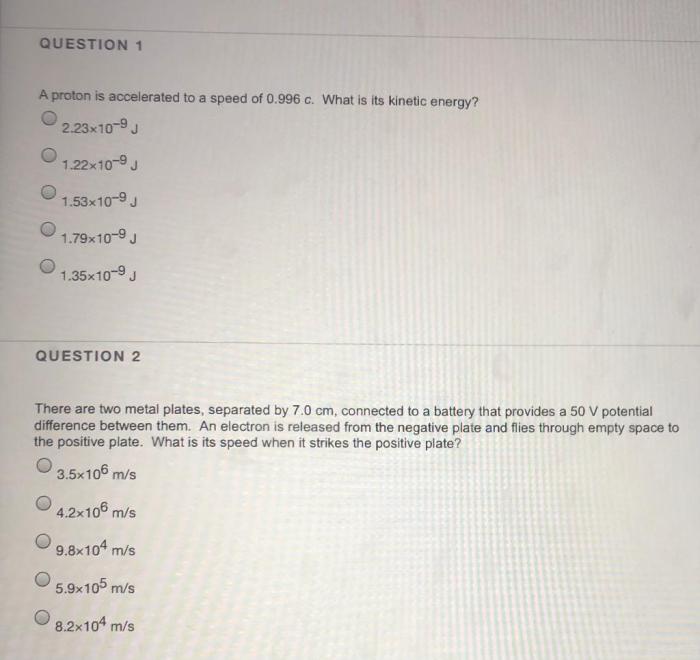A proton is accelerated to 0.999 c . – A proton is accelerated to 0.999c, embarking on a captivating scientific expedition that delves into the realm of relativistic physics. This remarkable feat opens up a world of fascinating phenomena, challenging our classical understanding of space, time, and matter.
As the proton approaches the speed of light, its energy and momentum soar, leading to a myriad of intriguing effects. Time dilation slows down the proton’s internal clock, while length contraction shrinks its dimensions along the direction of motion. These relativistic effects have profound implications for our comprehension of the universe.
Introduction
Particle acceleration is a fundamental concept in physics, involving the increase in the velocity of charged particles using electric fields or other means. This process plays a crucial role in various scientific fields, including nuclear physics, particle physics, and astrophysics.
In the specific case of a proton being accelerated to 0.999 c (where c represents the speed of light), this signifies a significant achievement in particle acceleration technology. Achieving such high velocities enables scientists to probe the fundamental properties of matter and explore new frontiers in physics.
Significance of Proton Acceleration
Accelerating protons to near-light speeds provides several advantages:
- Increased Energy:Higher velocities translate to higher kinetic energy, allowing for deeper insights into particle interactions and subatomic processes.
- Relativistic Effects:At velocities close to the speed of light, relativistic effects become pronounced, offering opportunities to study the behavior of matter under extreme conditions.
- Particle Production:Collisions between high-energy protons can create new particles, enabling the study of particle physics and the Standard Model.
Kinematic Effects: A Proton Is Accelerated To 0.999 C .

When a proton is accelerated to 0.999 c, it experiences significant relativistic effects that deviate from classical Newtonian predictions.
Relativistic Energy and Momentum
The relativistic energy (E) and momentum (p) of the proton can be calculated using the following equations:
E = γmc², p = γmv
where γ is the Lorentz factor, m is the rest mass of the proton, v is its velocity, and c is the speed of light.
At 0.999 c, γ ≈ 22.4, resulting in a relativistic energy of approximately 22.4 MeV and a momentum of approximately 49.2 MeV/c.
Time Dilation and Length Contraction
Due to time dilation, the proton’s time slows down as observed from a stationary frame of reference. Its proper time (τ) is related to the time (t) measured in the laboratory frame by:
τ = t/γ
At 0.999 c, the proton’s proper time is approximately 4.4% of the time measured in the laboratory frame.
Similarly, due to length contraction, the proton’s length (L) along the direction of motion is shortened as observed from a stationary frame of reference. Its proper length (L₀) is related to the length (L) measured in the laboratory frame by:
L = L₀/γ
At 0.999 c, the proton’s proper length is approximately 4.4% of the length measured in the laboratory frame.
Comparison to Classical Newtonian Predictions
In classical Newtonian physics, the proton’s energy and momentum would be calculated using E = ½mv² and p = mv, respectively. At 0.999 c, these classical predictions would yield significantly lower values than the relativistic calculations, highlighting the importance of relativistic effects at high speeds.
Additionally, classical Newtonian physics does not predict time dilation or length contraction, which are fundamental consequences of the theory of special relativity.
Interactions with Matter

As the proton approaches the speed of light, its interactions with matter become significantly altered due to relativistic effects.
At such high speeds, the proton’s mass increases dramatically, resulting in increased momentum and kinetic energy. Consequently, its interactions with other particles become more energetic and have a greater impact.
Relativistic Collisions
Relativistic collisions are those involving particles moving at speeds close to the speed of light. In such collisions, the relativistic increase in mass and energy leads to:
- Increased collision cross-sections, making it more likely for the proton to interact with other particles.
- Production of secondary particles, as the high energy of the collision can create new particles from the interacting particles.
- Emission of high-energy radiation, such as X-rays or gamma rays, as the proton loses energy through interactions.
Applications, A proton is accelerated to 0.999 c .
Relativistic protons have numerous applications in particle physics and other fields:
- Particle accelerators:Relativistic protons are used in particle accelerators to probe the fundamental constituents of matter and study high-energy physics.
- Cancer therapy:Proton beam therapy utilizes relativistic protons to deliver targeted radiation to tumors, minimizing damage to surrounding healthy tissue.
- Space exploration:Relativistic protons are present in cosmic rays and can provide valuable insights into astrophysical phenomena.
Experimental Considerations

Accelerating protons to 0.999 c is a challenging task that requires specialized experimental setups and techniques. These experiments involve accelerating protons to extremely high speeds using particle accelerators, such as synchrotrons or cyclotrons.
One of the challenges in these experiments is the need for precise control over the acceleration process. The protons must be accelerated gradually to avoid damaging the equipment or causing the protons to lose energy. Additionally, the experimental setup must be designed to minimize energy loss due to collisions with residual gas molecules in the accelerator chamber.
Real-World Experiments
Several real-world experiments have successfully accelerated protons to 0.999 c. One example is the Large Hadron Collider (LHC) at CERN, which has accelerated protons to energies of 13 TeV, corresponding to a speed of 0.9999999999 c.
Applications

Relativistic protons find applications in various fields due to their high energy and penetration power.
Particle Physics
In particle physics, relativistic protons are used as projectiles in particle accelerators to study the fundamental interactions and properties of subatomic particles. The high energy of protons allows for the creation and study of new particles and the exploration of the fundamental forces governing the universe.
Medical Imaging
Relativistic protons are used in medical imaging techniques such as proton computed tomography (pCT) and proton magnetic resonance imaging (pMRI). pCT provides high-resolution images of the body, particularly for detecting and characterizing tumors, due to the superior penetration and scattering properties of protons compared to X-rays.
pMRI offers improved sensitivity and specificity in imaging soft tissues, providing valuable information for diagnosing and monitoring various diseases.
Cancer Therapy
Relativistic protons are employed in cancer therapy, known as proton therapy, which delivers highly precise and targeted radiation to tumors. Protons deposit their energy over a shorter range than other radiation therapies, minimizing damage to surrounding healthy tissues. Proton therapy is particularly effective in treating deep-seated tumors and tumors located near critical structures, reducing the risk of side effects and improving treatment outcomes.
Space Exploration
Relativistic protons are present in cosmic rays, which originate from various sources in the universe. Studying cosmic rays provides valuable insights into astrophysical phenomena, such as supernova explosions, black hole formation, and the evolution of galaxies. Additionally, relativistic protons pose a significant radiation hazard to astronauts during space missions, requiring appropriate shielding measures to ensure their safety.
Expert Answers
What is the significance of accelerating a proton to 0.999c?
It allows us to study relativistic effects and gain insights into the fundamental nature of particles and their interactions.
How does time dilation affect the proton?
Time dilation slows down the proton’s internal clock, causing it to experience time at a slower rate compared to an observer at rest.
What are the potential applications of relativistic protons?
Relativistic protons have applications in particle physics, medical imaging, cancer therapy, and space exploration.